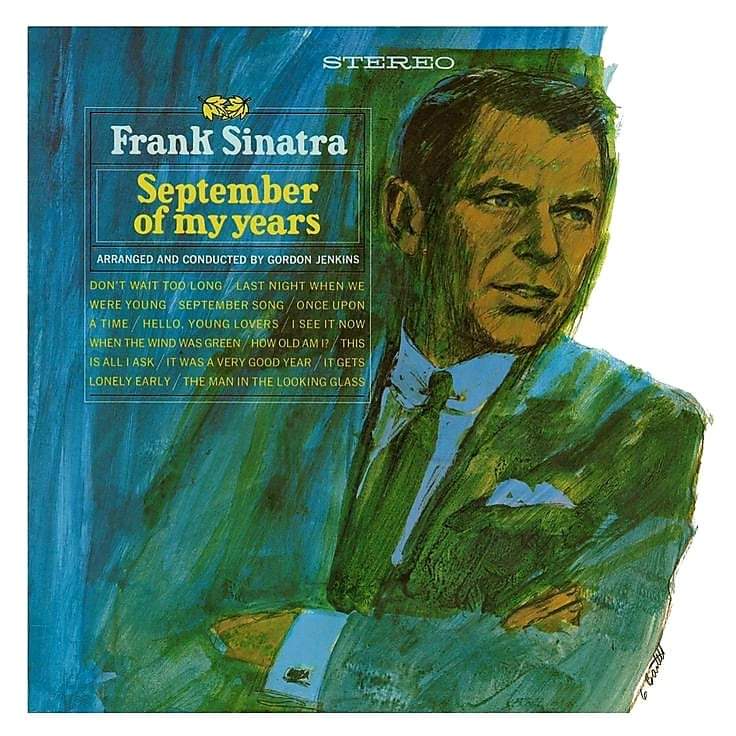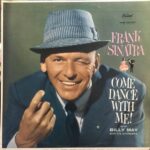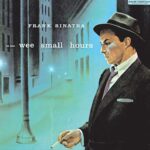
SEPTEMBER OF MY YEARS
By Mahnuel Muñoz
In 1965 Frank Sinatra turns 50, his career enjoys solid prestige regardless of sociocultural variables, and his personal life, although it has never been restful, sways with certain trade winds of calm. He has never seemed to have a problem enjoying every moment, and squeezing out even the smallest drop, even if it was to the detriment of his own flesh.
The romance he lives with Mia Farrow, thirty years younger than him, inspires him to look kindly at his own life path and capture that contemplation in the most majestic musical canvas of his production with Reprise, which he begins recording in the heat of spring from 1965. “September Of My Years” is perhaps the most honest work of The Voice’s career. Moving away from his binary formula of swing and love ballads, Frank sings about the passage of time and aging, opening a door to the more human chamber of his soul. It is an album of memories macerated in the heat of autumn bronze and a glass of wine, a box full of photos and clippings, of words and feelings thrown into the wind of an amazing life.
On August 21, 1965, the album entered the Billboard charts, where it remained for 69 weeks and reached number 5.
It shocked critics and the music industry, which awarded him four Grammy Awards (Record of the Year, Best Vocal Performance, Best Cover Notes and Best Arrangements).
FRANK SINATRA RADIO
Many of the songs are new, but the melancholic arrangements of Gordon Jenkins, the master of violin cries, and Frank’s introspective playing make them sound like beautiful old standards: the moving “It Was A Very Good Year” is an example. , a folk piece by the Kingston Trio born in 1961 that Frank and Gordon made their own forever.
This album is a beautiful thief of tears; Rarely can we hear Sinatra be so open with his feelings and that is something simply irresistible for any soul with a shred of sensitivity.
It is a fundamental work to understand the man and the artist, and it also helps us understand ourselves; Facing the September of our years puts us in the position of building our definitive “I”, the one with which we will say goodbye to this world and by which they will remember us. Taking care of each step and directing it towards personal and spiritual excellence is an obligation, if not to leave an example to follow, at least to erect a monument to the privilege of life on this strange and wonderful planet.
“September Of My Years” is a work of love and gratitude, almost an oratorio, which reflects on the effects of time on the pleasure that beauty provides – due to its ephemeral nature – as Georg Friedrich Händel already did in “The Triumph of time and disappointment” in 1707. In both works the luminous beauty of the music seems to resist the underlying message that grants triumph to the inexorable ticking of the clock. Both artists seem to want the melodies to live in our ears forever, to the detriment of wrinkles and ailments. Music is, perhaps without discussion, the most effective resource with which human beings can stop the unstoppable, cruel and ungraspable assembly line of a time that is lost almost at the moment of being conceived. Music is the art of time; plays with it at will, deconstructs it, stops it and pushes it forward without contemplation.
Each song on “September Of My Years” is a powerful manifesto emerged between verses to the simple enjoyment of the beauty that reveals and rebels even in the bitter folds of existence. Here Sinatra is a man aware of beginning to live, as Alberto Cortez would say, “half of his death”, he humbly thanks what he has received and faces his future with integrity. Although the October, November and December of his years reserved numerous professional pinnacles and the desired sentimental stability, in this work the singer writes his life testament and bequeaths us the most valuable teachings of his teaching, with the simplicity of geniuses and the complexity of most common in humans. If I had to summarize what I have learned with this album in one sentence, I would resort to the last words of “The Man In The Looking Glass”:
“Life is worth living if once in a while you can look at the looking glass and smile.”
Access the Complete Discography of Frank Sinatra in the following link of Sinatra Radio 24h https://sinatraradio24h.com/category/discography/
















